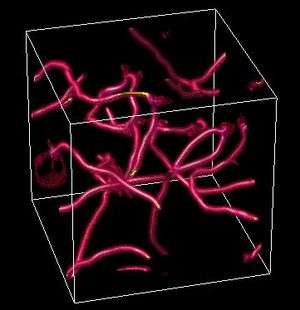January 29, 2008 feature
String Theory Gets a Boost

Among the scientific theories that excite a great deal of controversy are those theories that deal with strings. And the idea of cosmic strings gets as much play as any in scientific circles.
Cosmic strings are present in many high-energy physics theories. They are thought to be spaghetti-like structures, each mile weighing perhaps as much as our entire planet. Despite the weight, widths are thought to be significantly smaller than an atom. However, their existence has yet to be detected. Now, though, a team of cosmologists has discovered some hints that cosmic strings exist.
“At the moment,” Martin Kunz, a scientist at the University of Geneva when the paper was written, tells PhysOrg.com, “what we have found slightly prefers, or at least does not disfavor, cosmic strings.” Kunz is part of a team led by Mark Hindmarsh of the University of Sussex in Brighton, U.K., using measurements of the cosmic microwave background radiation to search for evidence of cosmic strings. This team, which includes Neil Bevis at Imperial College in London and Jon Urrestilla at Tufts University in Medford, Massachusetts, USA, have reported their findings in Physical Review Letters: “Fitting Cosmic Microwave Background Data with Cosmic Strings and Inflation.”
“As these strings move around,” Kunz explains, “they will cause perturbations, attracting matter behind them. These perturbations become visible in the comic microwave background radiation. If there are cosmic strings, they induce extra perturbations that could be indirectly detected.”
In order to determine whether cosmic strings might be possible, Kunz and his peers factored a variety of parameters into a supercomputer and created different models. “We made new simulations of traces of cosmic strings,” Kunz says. “We calculated perturbations from standard inflation and calculated them from cosmic strings. We did model comparisons.”
The result was that, after predictions were compared to cosmic microwave data from NASA’s Wilkinson Microwave Anisotropy Probe, it appeared that theories including cosmic strings offer the best explanation for the pattern of microwave radiation present in the universe.
Kunz cautions that cosmic strings are far from an absolute. “We need more data,” he insists. “While this result slightly favors cosmic strings, it isn’t conclusive.” Kunz says that better data may come from the Planck Satellite mission, which is due for launch this year by the European Space Agency.
“If we could detect strings,” Kunz points out, “it would tell us a lot about particle physics, and help us understand more about the fundamental structure of physics at very high energies, much higher than what can be probed in particle accelerators. Finding strings would be very helpful in areas of fundamental theory.”
Until more data is gathered, and more work done in the field, cosmic strings are likely to remain a subject of scientific debate. But this latest work on cosmic strings is encouraging for those who subscribe to string theory – a theory that could possibly tie quantum physics and gravity together, as well as provide a fundamental understanding of high-energy and condensed matter physics.
“What this does is show that cosmic strings could account for what we can detect in the universe,” Kunz says. “It doesn’t prove anything, and we do need more data. But it does show us that cosmic strings are worth looking at again. We haven’t detected them yet, but it’s something to watch for.”
Copyright 2008 PhysOrg.com.
All rights reserved. This material may not be published, broadcast, rewritten or redistributed in whole or part without the express written permission of PhysOrg.com.





















